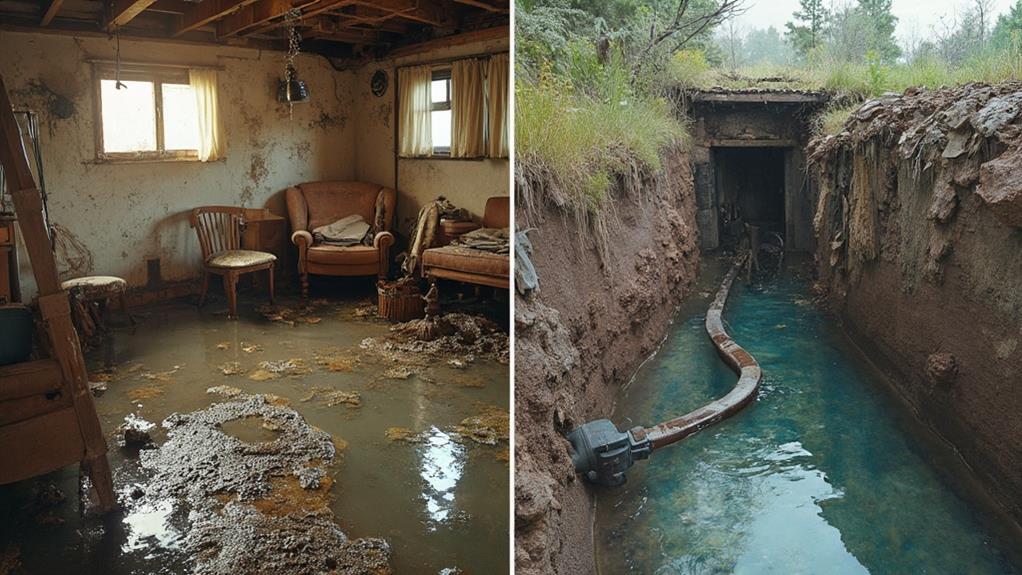Foundation flooding can lead to severe long-term consequences, including structural instability, mold growth, and decreased property value. Water infiltration erodes soil, weakens structural components, and creates ideal conditions for mold proliferation, posing significant health risks. Electrical systems may suffer damage, creating potential safety hazards. Repair costs can be substantial, ranging from minor crack filling to complete foundation replacement. Preventative measures, such as proper drainage and waterproofing techniques, are crucial for mitigating these risks. Insurance considerations are also important, as standard policies often exclude flooding-related damage. Understanding these consequences and implementing effective solutions can safeguard your home's integrity and value for years to come.
Structural Damage and Instability
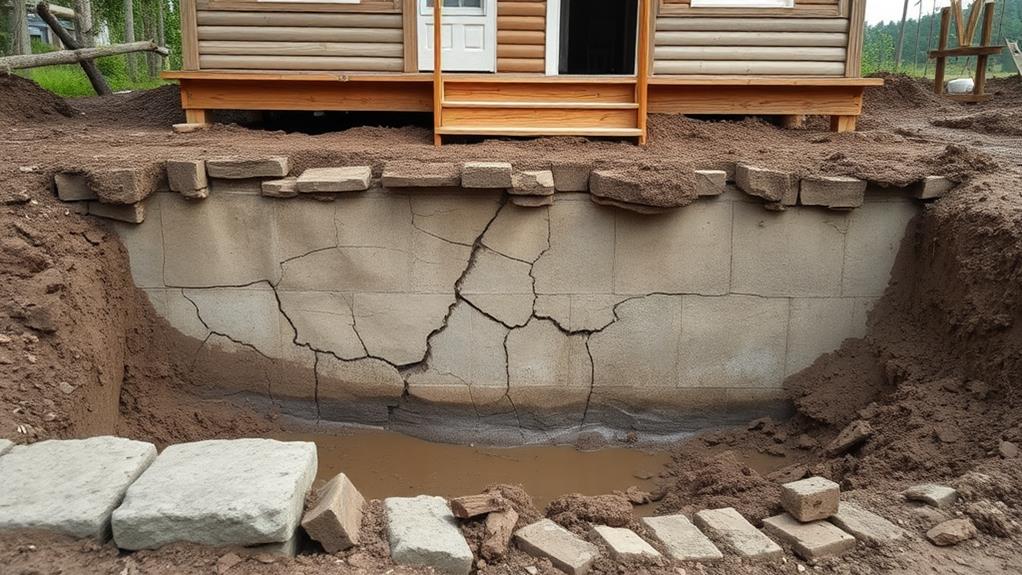
The integrity of a building's foundation is paramount to its overall stability and longevity. When foundation flooding occurs, it can lead to severe structural damage and instability over time. As water infiltrates the foundation, it erodes soil and weakens the structural components, potentially causing settling, cracking, and shifting of the building.
Prolonged exposure to moisture can deteriorate concrete, corrode steel reinforcements, and compromise the foundation's load-bearing capacity. This deterioration may manifest as visible cracks in walls, uneven floors, or doors and windows that no longer close properly.
In extreme cases, foundation flooding can lead to partial or complete structural failure. The damage caused by foundation flooding often extends beyond the immediate affected area. It can impact the entire building's structural integrity, compromising its safety and value.
Additionally, the moisture intrusion creates an ideal environment for mold growth, further degrading building materials and posing health risks to occupants. Addressing foundation flooding promptly is crucial to mitigate long-term consequences. Professional assessment, waterproofing measures, and structural repairs are essential steps in preserving the building's stability and preventing further damage.
Mold and Health Risks
Addressing mold growth is a critical concern following foundation flooding, as it poses significant health risks to building occupants. Mold thrives in damp environments, and flood-damaged foundations provide ideal conditions for its proliferation. Within 24-48 hours of water exposure, mold can begin to grow on various surfaces, including drywall, insulation, and wood framing.
The health effects of mold exposure can range from mild to severe. Common symptoms include respiratory issues, allergic reactions, and skin irritation. For individuals with pre-existing respiratory conditions or compromised immune systems, the risks are even greater.
Prolonged exposure to certain types of mold, such as black mold (Stachybotrys chartarum), can lead to more serious health complications.
To mitigate these risks, swift action is essential. Proper drying and dehumidification of affected areas should be initiated immediately after flooding subsides. Professional mold remediation may be necessary for extensive contamination. Additionally, regular inspections and maintenance of the foundation can help prevent future water intrusion and subsequent mold growth. Implementing proper ventilation and moisture control measures can further reduce the likelihood of mold recurrence, safeguarding both the structure and its occupants' health.
Decreased Property Value
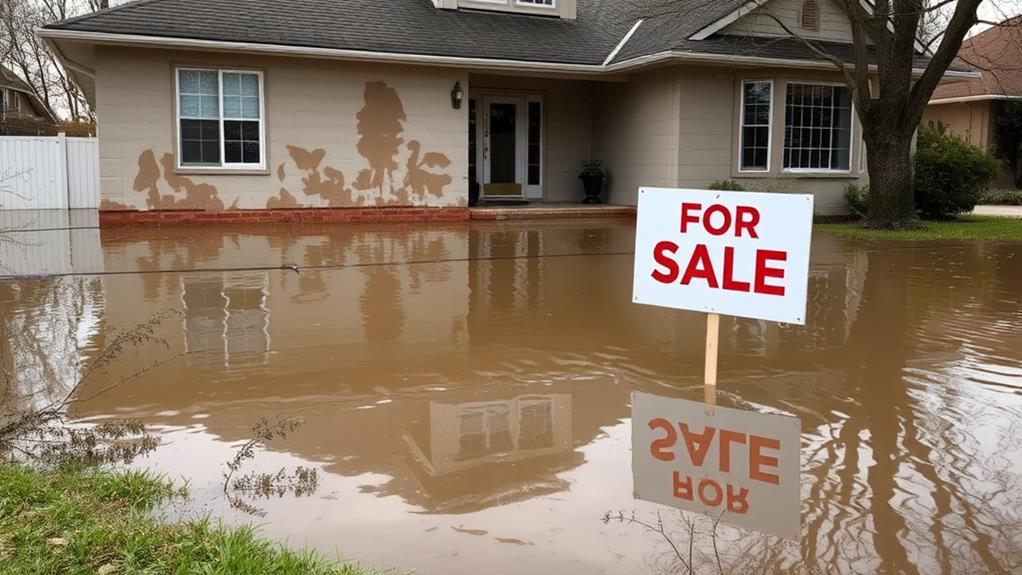
Foundation flooding can significantly impact a property's market value, often leading to a substantial decrease in its worth. This depreciation stems from various factors, including structural damage, potential health hazards, and the stigma associated with previously flooded properties.
Structural issues caused by foundation flooding, such as cracks, shifts, or weakened support, can be costly to repair and may deter potential buyers. Even after remediation, the risk of future flooding can make a property less desirable. Disclosure laws in many areas require sellers to inform potential buyers about past flooding events, which can further impact marketability.
The presence of mold or other water-related damages can also contribute to decreased property value. These issues may require extensive renovations or pose ongoing health risks, making the property less attractive to prospective buyers. Additionally, properties in flood-prone areas may face higher insurance premiums or difficulty obtaining coverage, further reducing their appeal and value.
To mitigate the impact on property value, homeowners should address foundation flooding promptly, implement preventive measures, and maintain detailed records of all repairs and improvements. Professional assessments and certifications can also help restore confidence in the property's condition and potentially preserve its market value.
Electrical System Hazards
Numerous electrical system hazards can arise from foundation flooding, posing significant risks to both property and occupants. Water infiltration can damage electrical components, corrode wiring, and create short circuits, leading to potential fire hazards or electrocution risks. Moisture in electrical panels, outlets, and junction boxes can compromise the integrity of the entire system, necessitating extensive repairs or complete replacement.
Floodwater often contains contaminants that can further degrade electrical equipment, accelerating corrosion and increasing the likelihood of system failure. Even after visible water recedes, residual moisture within walls and flooring can continue to affect hidden wiring, creating long-term safety concerns. Ground fault circuit interrupters (GFCIs) may malfunction due to water exposure, reducing their effectiveness in preventing electric shocks.
To mitigate these hazards, it is crucial to have a professional electrician inspect the entire electrical system following a flooding event. This inspection should include assessment of wiring, outlets, switches, and circuit breakers. In many cases, affected components will need to be replaced to ensure safety and compliance with local building codes. Additionally, implementing preventive measures such as elevating electrical systems and installing water-resistant materials can help reduce the risk of future flood-related electrical hazards.
Foundation Repair Costs
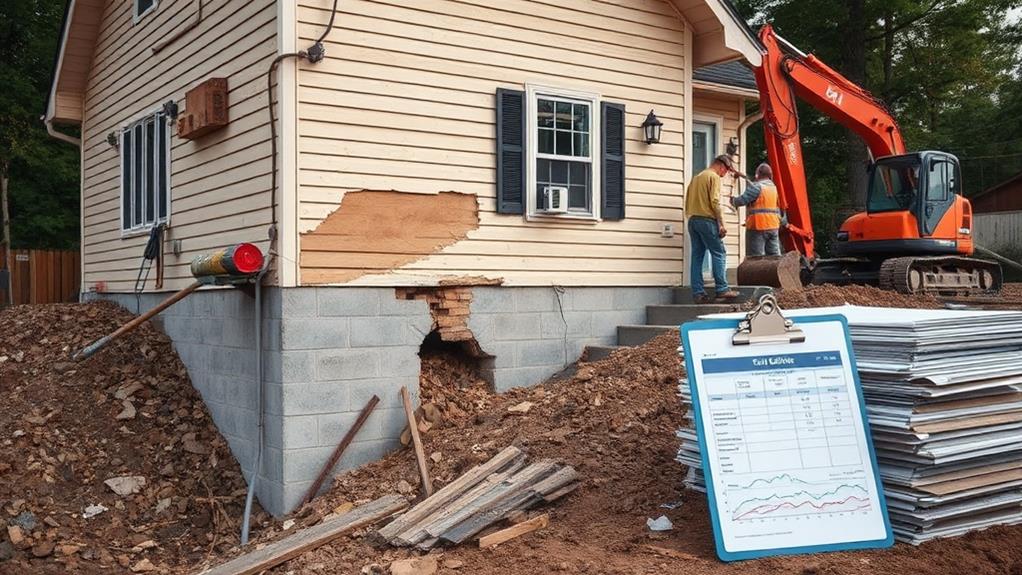
Estimating the costs associated with foundation repair after flooding can be a complex and often sobering process for homeowners. The extent of damage and necessary repairs can vary significantly, depending on factors such as flood severity, duration of water exposure, and the foundation's pre-existing condition.
Minor repairs, such as filling cracks or applying waterproof sealants, may cost between $500 and $3,000. However, more extensive damage requiring structural repairs can escalate costs dramatically.
Major foundation repairs, including underpinning or installing piers, can range from $5,000 to $35,000 or more. In severe cases where complete foundation replacement is necessary, costs can exceed $100,000. Additional expenses may include soil stabilization, drainage system improvements, and mold remediation.
It's crucial to factor in potential increases in insurance premiums and decreased property value when assessing the total financial impact. Homeowners should obtain multiple quotes from reputable contractors and consider seeking advice from structural engineers to ensure accurate cost estimates.
While the expense can be significant, addressing foundation issues promptly is essential to prevent further damage and maintain the home's structural integrity and value.
Preventative Measures
Proactive homeowners can implement several preventative measures to mitigate the risk of foundation flooding and subsequent damage. Proper grading and landscaping are essential, ensuring that the ground slopes away from the foundation to direct water runoff. Installing and maintaining gutters and downspouts helps channel rainwater away from the house, preventing water accumulation near the foundation.
A robust drainage system, including French drains or a sump pump, can effectively remove excess water from the soil surrounding the foundation. Regularly inspecting and sealing foundation cracks, as well as waterproofing basement walls, create additional barriers against water infiltration. Installing a backwater valve can prevent sewage backup during heavy rainfall or flooding events.
Proper maintenance of nearby trees and shrubs is crucial, as their roots can damage foundation walls and create pathways for water intrusion. Homeowners should also consider investing in flood-resistant materials for basement finishing and storing valuable items on elevated platforms. Regular foundation inspections by professionals can identify potential vulnerabilities before they escalate into significant problems. By implementing these preventative measures, homeowners can significantly reduce the risk of foundation flooding and protect their property's structural integrity.
Waterproofing Techniques
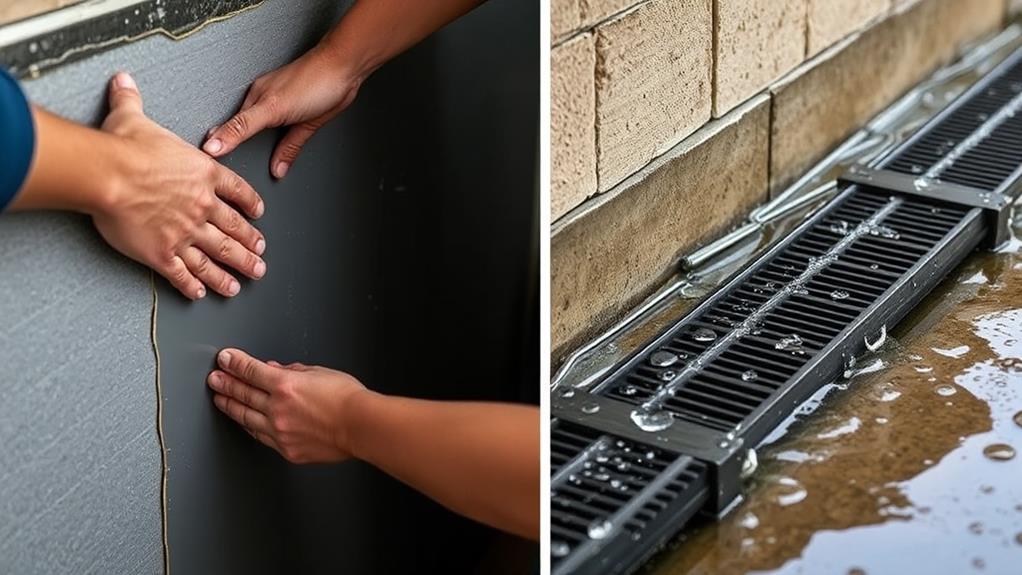
Waterproofing solutions play a crucial role in protecting foundations from water damage and flooding. These techniques can be broadly categorized into interior and exterior waterproofing methods.
Interior waterproofing involves applying sealants or coatings to the inside of basement walls and floors, as well as installing drainage systems to redirect water away from the foundation. Common interior techniques include the use of hydraulic cement, waterproof paint, and crack injection systems.
Exterior waterproofing, considered more effective but often more costly, focuses on preventing water from reaching the foundation walls. This typically involves excavating around the foundation, applying waterproof membranes or coatings, and installing proper drainage systems. French drains, weeping tiles, and gravel backfill are frequently used in exterior waterproofing projects. Additionally, the application of bentonite clay or rubberized asphalt membranes can provide a robust barrier against water infiltration.
For optimal protection, a combination of both interior and exterior waterproofing techniques is often recommended. Regular maintenance and inspection of these systems are essential to ensure their continued effectiveness in safeguarding the foundation against water-related issues.
Insurance Considerations
Insurance policies related to foundation flooding can be complex and vary significantly between providers. Homeowners should carefully review their coverage to understand what types of water damage are included. Standard policies often exclude flooding, requiring separate flood insurance. It's crucial to distinguish between water damage from internal sources (e.g., burst pipes) and external flooding, as they may be treated differently by insurers.
Some policies may cover foundation damage resulting from sudden, accidental events but exclude gradual seepage or long-term water exposure. Homeowners should consider additional endorsements or riders to enhance their coverage for foundation-related issues. When purchasing insurance, it's advisable to consult with an agent familiar with local flood risks and foundation problems.
In the event of a claim, thorough documentation is essential. This includes photographs, repair estimates, and professional assessments of the damage. Policyholders should be aware of claim filing deadlines and any specific requirements for foundation-related issues. Regular maintenance and implementing preventive measures can not only protect the property but may also positively impact insurance premiums and coverage options.
Frequently Asked Questions
How Long Does It Take for Flood Water to Damage a Foundation?
Flood water can begin damaging a foundation almost immediately upon contact. However, significant structural damage typically occurs within 24 to 48 hours of continuous exposure. The extent of damage depends on water depth, duration, and foundation materials.
Can Foundation Flooding Affect Indoor Air Quality Even After Drying Out?
Yes, foundation flooding can affect indoor air quality even after drying out. Moisture can lead to mold growth, which releases spores into the air. Additionally, floodwater contaminants may leave residues that continue to impact air quality over time.
Are There Any Government Assistance Programs for Foundation Flood Damage Repair?
Oh, government assistance for flood damage? Sure, they're just swimming in funds! Jokes aside, some programs like FEMA's Individuals and Households Program or HUD's Community Development Block Grant can provide financial aid for foundation flood damage repairs.
How Often Should I Inspect My Foundation for Signs of Water Damage?
Professional foundation inspections should be conducted annually, while homeowners should perform visual checks quarterly. After heavy rainfall or snowmelt, additional inspections are advisable. Look for cracks, dampness, mold, or unusual odors indicating potential water damage or moisture issues.
Can Landscaping Changes Help Prevent Foundation Flooding in High-Risk Areas?
Shockingly, 60% of homes experience foundation issues. Landscaping changes can significantly help prevent foundation flooding in high-risk areas. Proper grading, strategic plant placement, and installation of drainage systems can effectively divert water away from your home's foundation.
Conclusion
Foundation flooding poses severe long-term consequences, including structural damage, health risks, and financial burdens. Implementing preventative measures and waterproofing techniques is crucial for protecting homes and property values. Surprisingly, 98% of basements in the United States will experience some type of water damage during their lifespans. This statistic underscores the widespread nature of the issue and the importance of proactive solutions. Homeowners and insurers must work together to address this pervasive problem, ensuring the safety and longevity of residential structures.
